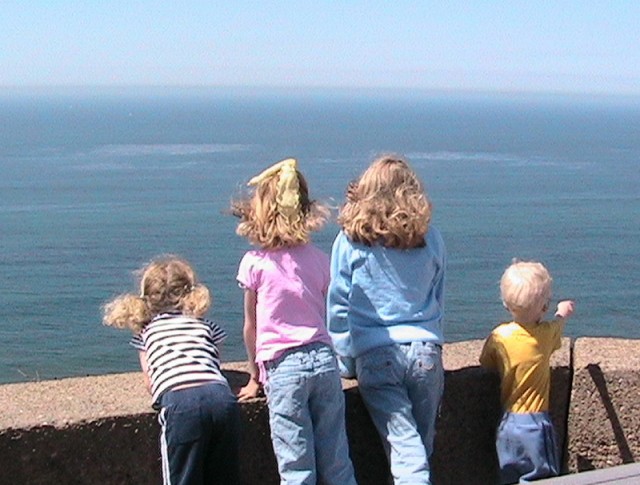“With practice, they begin to see carelessly”

A somewhat grainy photo of my four oldest children taken at the Point Loma Lighthouse in 2007, not long after we moved to San Diego. The Pacific was still quite new to them. When I coined the term “tidal homeschooling,” we lived in Virginia and the image was entirely figurative—but when I think back to those early tidal-learning days, this pic is the one I see.
I remember writing here long ago about how my favorite category of post was connections. The serendipitous links of thought we encounter when something we’re reading or experiencing echoes or relates to some earlier conversation, book, film, experience.
Today, for example: we read another Hauge poem (“Winter Morning”) and had a really rich discussion of how much is going on in those four simple lines—a discussion that incorporated some of the conversation we had in the comments here about yesterday’s poem. We talked about the way Hauge uses simple, crisp, concrete images (frosted windowpanes, the glow of a good dream, a woodstove “pour[ing] out its warmth/ from a wood block it had enjoyed the whole night”) to describe a moment, and something much bigger than the moment. And from that rather animated discussion we jumped to Linda Gregg’s “Art of Finding” essay:
I am astonished in my teaching to find how many poets are nearly blind to the physical world. They have ideas, memories, and feelings, but when they write their poems they often see them as similes. To break this habit, I have my students keep a journal in which they must write, very briefly, six things they have seen each day—not beautiful or remarkable things, just things. This seemingly simple task usually is hard for them. At the beginning, they typically “see” things in one of three ways: artistically, deliberately, or not at all. Those who see artistically instantly decorate their descriptions, turning them into something poetic: the winter trees immediately become “old men with snow on their shoulders,” or the lake looks like a “giant eye.” The ones who see deliberately go on and on describing a brass lamp by the bed with painful exactness. And the ones who see only what is forced on their attention: the grandmother in a bikini riding on a skateboard, or a bloody car wreck.
But with practice, they begin to see carelessly and learn a kind of active passivity until after a month nearly all of them have learned to be available to seeing—and the physical world pours in. Their journals fill up with lovely things like, “the mirror with nothing reflected in it.” This way of seeing is important, even vital to the poet, since it is crucial that a poet see when she or he is not looking—just as she must write when she is not writing. To write just because the poet wants to write is natural, but to learn to see is a blessing. The art of finding in poetry is the art of marrying the sacred to the world, the invisible to the human.
Okay, here’s the thing. I had planned to read this excerpt of Gregg’s essay, and to introduce a new practice for the four of us—Huck, Rilla, Scott, and me. We have a spiral-bound sketchbook that, at intervals, we use as a shared family journal. In 2020 it was the whole family chiming in with quips, sketches, and interesting tidbits. It went dormant last year, and when the Linda Gregg passage resurfaced in my Readwise review over the holidays, I decided to appropriate the journal for this practice. Maybe not daily, but several times a week, we’ll jot down things we’ve seen or heard.
But weeks have passed since I reread the passage, and I’d forgotten that last line—the “marrying of the sacred to the world, the invisible to the human.” That’s exactly what we’d just been talking about with the Hauge poem, and what we talked about yesterday. The way he expresses a single image that speaks vividly both as a literal description (in a way that makes your breath catch) and as a reflection on some aspect of human experience. “Marrying the sacred to the world” is what Hauge does best.
So: part intention, part serendipity. The best kind of high-tide morning.
_____________________
A postscript added after I made today’s recording—listening to the Linda Gregg passage read aloud, I got to “the art of finding” and went Oh of course! And made a note to let tomorrow’s poem be Elizabeth Bishop’s “One Art.” Another connection.
connections, high tide, homeschooling high school, Linda Gregg, Olav Hauge, Tidal Homeschooling, tidal learning

Amy says:
Those types of connections were the absolute best part of our homeschooling days to me, and I was amazed at how often they happened. I guess when you drink deep of the world and talk what feels like 24/7 you’ll eventually bump into two things that match occasionally. 🙂 And that quote you shared was something I needed to hear today! I have so much trouble getting out of my head into the real world. I will now try to see carelessly.
(just a little fyi I started blogging again…just a bit but it’s a start…at a little hideaway off of my main blog)
On January 10, 2023 at 6:16 pm